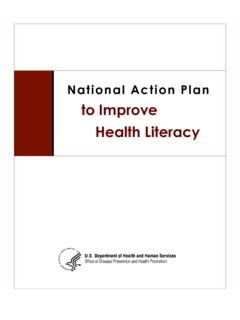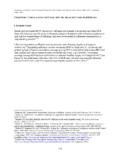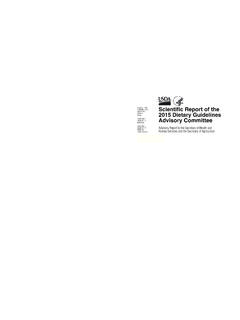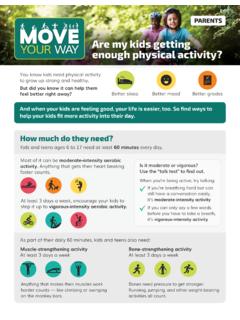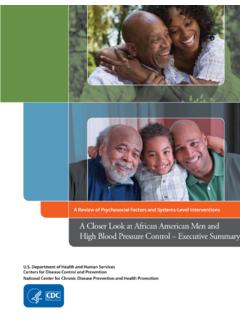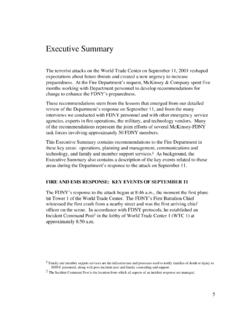Transcription of HAI Action Plan - Part 1: Executive Summary, Metrics, and ...
1 NATIONAL Action PLAN TO PREVENT HEALTH CARE-ASSOCIATED INFECTIONS: ROAD MAP TO ELIMINATION. APRIL 2013. part 1: Executive summary , metrics , and goals . I. INTRODUCTION. A. Magnitude of the Problem Health care-associated infections (HAIs) are infections that people acquire while they are receiving treatment for medical or surgical conditions in a health care setting. HAIs can be acquired anywhere health care is delivered. Hospital-acquired HAIs are among the leading causes of death in the United States. At any given time, about one in every 20 hospitalized patients has an HAI, while over one million HAIs occur across health care every year. Hospital- acquired HAIs alone are responsible for $28 billion to $33 billion in potentially preventable health care expenditures annually. Scientific evidence has shown that certain types of HAIs can be drastically reduced to save lives and avoid excess costs.
2 B. Context of the Executive summary The information that is to follow should be used along with the Framework of the National Action Plan to Prevent Health Care-Associated Infections: Road Map to Elimination (HAI. Action Plan). While the Executive summary provides brief summaries of the first eight chapters of the HAI Action Plan, enumerates the HAI Action Plan national measures and goals , and introduces key concepts important to the overall HAI prevention initiative, the Framework expands on these key concepts. The Framework also provides additional details complementary to those in the Executive summary . Both documents are intended for public health professionals, clinicians, advocates, and policy makers. Chapters Five through Eight of the HAI Action Plan, which are categorized by Phases according to the health care setting or focus and time of development, can be used as stand-alone documents for stakeholders involved in the control and prevention of HAIs in that specific setting or focus area.
3 C. A National Focus on Improving Health Care Quality To coordinate HAI prevention efforts across the federal government, a senior-level Steering Committee for the Prevention of Health Care-Associated Infections was established in 2008. Members of the Steering Committee include clinicians, scientists, and public health leaders from the: Department of Health & Human Services (HHS): o Agency for Healthcare Research and Quality (AHRQ). o Administration for Community Living (ACL). o Centers for Disease Control and Prevention (CDC). o Centers for Medicare & Medicaid Services (CMS). o Food and Drug Administration (FDA). o Health Resources and Services Administration (HRSA). o Indian Health Service (IHS). o National Institutes of Health (NIH). 1. NATIONAL Action PLAN TO PREVENT HEALTH CARE-ASSOCIATED INFECTIONS: ROAD MAP TO ELIMINATION. APRIL 2013. o HHS Office of the Secretary (OS). Office of the Assistant Secretary for Health (OASH).
4 National Vaccine Program Office (NVPO). Office of Disease Prevention and Health Promotion (ODPHP). Office of the Assistant Secretary for Planning and Evaluation (ASPE). Office of the National Coordinator for Health Information Technology (ONC). Department of Defense (DoD). Department of Veterans Affairs (VA). Given the substantial breadth and depth of HAIs, the Steering Committee decided to take a phased approach when developing the National Action Plan to Prevent Health Care-Associated Infections: Roadmap to Elimination. The initial HAI Action Plan was released in 2009 with a focus on HAI prevention in acute care hospitals, referred to as Phase One of the HAI Action Plan. Phase One addresses the most common infections in acute care inpatient settings and outlines specific recommended clinical practices, a prioritized research agenda, an integrated information systems strategy, policy options for linking payment incentives or disincentives to quality of care and enhancing regulatory oversight of health care facilities, and a national messaging and communications plan to raise awareness of HAIs among the general public and prevention strategies among health care workers.
5 Experts and other stakeholders set five-year (by the end of 2013) HAI reduction goals or targets in the HAI Action Plan and identified metrics and accompanying measurement systems to assess progress towards the reduction of specific HAIs and adherence to recommended prevention practices (see section V below). Following the release of the 2009 HAI Action Plan, the Steering Committee expanded its scope to include both the outpatient setting and the role of health care personnel (HCP) in ensuring optimal patient outcomes, referred to as Phase Two. Chapters developed for Phase Two include: (1) Prevention of HAIs in Ambulatory Surgical Centers (ASCs);. (2) Prevention of HAIs in End-Stage Renal Disease (ESRD) Facilities; and (3) Increasing Influenza Vaccination Coverage of HCP. Following the release of the Phase Two chapters, the Steering Committee's Long-Term Care Facilities (LTCFs) Working Group developed and released the LTCFs Chapter, which focuses on promising practices in infection control in nursing homes and skilled nursing facilities.
6 In the HAI Action Plan, LTCFs is also referred to as Phase Three. In April 2011, HHS launched the Partnership for Patients: Better Care, Lower Costs, a public- private initiative designed to improve the quality, safety, and affordability of health care for Americans. The first major goal of the Partnership for Patients is to keep patients from getting injured or sicker during the course of their care. Specifically, the initiative aims to decrease preventable hospital-acquired conditions by 40% compared with the 2010 rate. Achieving this goal would result in million fewer injuries to patients and more than 60,000 lives saved over three years. 2. NATIONAL Action PLAN TO PREVENT HEALTH CARE-ASSOCIATED INFECTIONS: ROAD MAP TO ELIMINATION. APRIL 2013. By implementing broad multiyear programs to significantly reduce harm in hospitals and reduce hospital readmissions through improved care and coordination across health care settings, the Partnership for Patients initiative carries out the broad aims of the National Strategy for Quality Improvement in Healthcare or the National Quality Strategy.
7 The National Quality Strategy, authorized by the Affordable Care Act, is a plan to improve the delivery of health care services, achieve better patient outcomes, and improve the health of the population through the coordination of public and private sector activities. The Partnership for Patients is committed to addressing all forms of harm that can affect patients in hospitals. As a starting point, the Partnership for Patients has identified nine areas of focus, including four HAIs: catheter-associated urinary tract infections (CAUTI), central line-associated bloodstream infections (CLABSI), surgical site infections (SSI), and ventilator-associated pneumonia (VAP). The reduction goals and timeline of the HAI Action Plan align with those of the Partnership for Patients. Whereas the Partnership for Patients focuses on acute care hospital settings, the HAI Action Plan extends its prevention efforts to other health care settings.
8 Under the Partnership for Patients umbrella, the HAI Action Plan is anticipated to contribute to substantial increases in patient safety and health care quality according to an escalated timetable, thereby achieving both human and economic cost savings. As demonstrated by the National Quality Strategy and the Partnership for Patients, HHS. increasingly looks to its multidisciplinary and multi-sector partners to co-develop and amplify key messages, increase the adoption of recommended practices, and serve as local, state, regional, and national leaders in a coordinated effort to eliminate HAIs. Achievement of the goal of eliminating preventable infections will provide significant advancement for the Partnership for Patients. D. Changing Landscape of HAI Prevention This section highlights some of the accomplishments and successes in the field of HAI. prevention seen over the last few years. Particularly notable items: Decreases in the national incidence of CLABSI, invasive methicillin-resistant Staphylococcus aureus (MRSA) infections, SSI, and CAUTI.
9 For additional data regarding progress toward accomplishing the HAI Action Plan goals , please go to the HHS HAI Initiative page, Investment in HAI research has increased, including in the field of implementation science. In addition, the Steering Committee's Research Working Group, chaired by AHRQ, and CDC's Prevention Epicenter research network have addressed priority gaps in prevention knowledge. More than 11,000 health care facilities have enrolled in CDC's National Healthcare Safety Network (NHSN) as of November 2012. CMS now requires health care facilities to report HAI Action Plan data to NHSN to fulfill CMS quality reporting requirements. The Comprehensive Unit-based Safety Program (CUSP) demonstrates how a structured strategic framework for safety can result in dramatic improvements in patient care. The approach was designed to improve the culture of safety and help clinical teams learn from mistakes by integrating safety practices into the daily work of a unit or clinical area.
10 3. NATIONAL Action PLAN TO PREVENT HEALTH CARE-ASSOCIATED INFECTIONS: ROAD MAP TO ELIMINATION. APRIL 2013. Hospitals adopting this approach in their intensive care units (ICUs) have achieved significant reductions in CLABSI. The more than 1,000 adult ICUs that participated in AHRQ's nationwide CUSP for CLABSI project reduced the rate of CLABSI by 41%, prevented more than 2,100 of these infections, saved more than 500 lives, and avoided more than $36 million in excess costs. AHRQ is currently expanding this effort to the prevention of other forms of HAIs, as well as to patient care areas of the hospital other than ICUs. To ensure that the HAI Action Plan is truly representative of the needs of the many partners and participants in the national effort to prevent HAIs, each of HHS' component Operating and Staff Divisions sponsored and/or conducted numerous activities in conjunction with OASH to ensure an on-going and vibrant dialogue with the many communities within public health and health care, as well as consumers.

